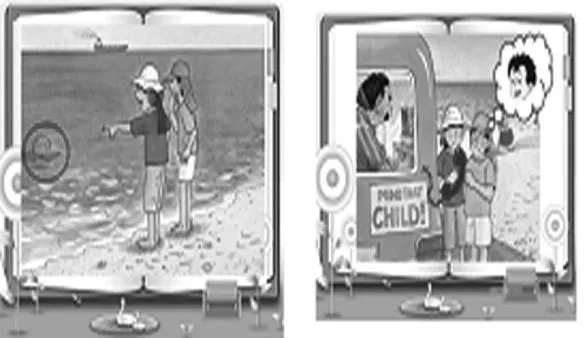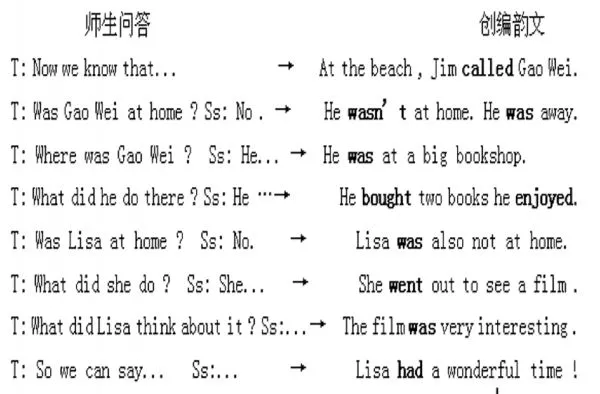一节绘本故事与会话课相结合的英语课堂教学
——以修订版PEP六(下)Unit 1(第三课时)为例
赵立英 张 鹏
最近,笔者听了一节六年级的英语课。授课教师在会话教学中适当引入了《典范英语》2A 中 Lesson 17“On the Beach”一课的故事,巧妙地将它与本课对话衔接在一起,从而使故事与对话融为一体,有效地激发了学生的学习兴趣,同时也收到了较好的教学效果,给笔者留下了深刻的印象。
一、教学过程
Step 1.Warm-up
1.一上课,教师便给学生介绍了两位新朋友Jim和Jane,并请他们猜测Jim和Jane上周末前往海滩所做的活动(见图1)。

图1
T:I’m going to introduce two new friends to you.This is Jim and this is Jane.Where are they?
S1:They are at the beach.
T:Yes.Last weekend,Jim and Jane went to the beach with their family.What did they do?Can you guess?
Ss:Maybe they...
2.猜测完两位新朋友在沙滩上做的活动后,教师和学生就上个周末所做的活动展开对话。对话内容如下:
T:They did a lot of things at the beach.How about you?What did you do last weekend?
S1:I played the piano last weekend.
T:Are you good at it?
S1:Yes,I am.
S2:I went to my friend’s home.
T:Whatdid you doat home?
S2:We drew some pictures.
S3: I bought some chocolates.
S4:Last weekend,I saw a film.
T:What do you think of the film?
S4:It was very interesting.
T:Your last weekend was just as interesting as theirs.
【设计意图】教师介绍两位新朋友,并借助相应问题的提出引发学生动脑思考,激活已有知识。通过与学生围绕“What did you do last weekend?”展开对话,既让学生了解本课的内容将围绕“谈论上周末的活动”展开,又在对话的过程中激活了学生已学的相关内容和已有的相关知识,复习了过去式的用法,为随后课文教学做好充分的铺垫。
Step 2.Presentation
1.Lead in
教师向学生介绍Jim和Jane到海滩各处游玩归来之后看到的情境,为随后导入课文的教学埋下伏笔(见图2)。

图2
T:When Jim and Jane came back to the beach,something happened...
T:What did they see?
Ss:They saw Dad’s cap.
T:Where was Dad?Do you know?
S1:Maybe he was sleeping on the beach.
S2:Maybe he was eaten by sharks.
T:Jim and Jane didn’t know either.So...
T:What did they do?
S1:They called Gao Wei.
教师教授本课新词called,并将其贴在黑板上。之后,教师设置给Gao Wei打电话无人接通的情境:Was Gao Wei at home?What did he do there?由此巧妙地将学生从《典范英语》的故事中带入到教材对话的背景里。
2.Dialogue Learning
(1)The First Round:
教师提出问题,学生借助观看视频的方式,对教材中的对话文本完成整体感知和理解,同时提取相应的答案。
T:Was Gao Wei at home?
(Ss watch the movie of the dialogue, and find out the answer.)
Ss (After watching the movie):No.
T:Where was Gao Wei?
S1: He was at the bookshop.
T:What did he do there?
S2:He bought a storybook and a book of cartoons.
(Ss listen and check.)
(2)The Second Round:
T:How about Lisa?Was Lisa at home last weekend?
Ss:No.
T:Where was Lisa?
(Ss watch the movie of the dialogue again,and find out the answer.)
S3 (After watching the movie):She was at the cinema,and she went to see a movie.
(Ss listen and check.)
【设计意图】通过在相应语境中的师生交流,提出针对课文对话内容的问题;随后借助观看视频提取相关问题答案的方式,学生完成对本课对话内容的感知和理解。
Step 3.Practice
1.Going over the text
学习课文对话内容后,学生先听录音跟读课文,再共同分角色朗读课文,然后再两人一小组分角色朗读课文。
【设计意图】通过听录音并跟读、整体分角色朗读和在小组内分角色朗读课文的形式,进一步熟悉并掌握本课所学相关语句的用法。
2.A Chant
教师带领学生通过问答的方式梳理出课文对话的主要内容,随后将梳理出来的语句创编成韵文(见图3)。


图3
【设计意图】将师生所创编的韵文配以有节奏的旋律,学生通过演唱韵文,在激发参与兴趣的同时,夯实动词过去式的表达法。
3.Information Gap
教师请学生相互询问对方在上个周末的活动。
T:Both Lisa and Gao Wei were not at home last weekend.So,when Jim and Jane called them,theycouldn’tgethelp from them.If they called you,could you help them?Were you at home last weekend?
Ss:Yes./No.
T:What did you do?
Ss:I...
(Students work in pairs to ask each other.)
【设计意图】学生相互间问答上个周末是否在家,在相应的情境中练习本课所学主要语句,从而逐渐巩固在日常交际中的用法。
Step 4.Production
1.Revealing the Result of the Story
课程进行到此,教师适时地向学生揭示“Jim and Jane’s Trip to the Beach”的结尾(见图4)。
T:Some of you could help them,and some of you couldn’t.It doesn’t matter.Now,let’s see where Dad really was.
T:Look!Where was Dad?
Ss:He was hiding behind!
T:Yes.Dad played a joke on Jim and Jane.So,what do you think of their trip to the beach?
Ss: It was interesting /fantastic/amazing...

图4
【设计意图】揭示故事结尾,与开头相呼应,在保持故事完整性的同时,通过学生对于这个故事的感受,自然导入对于彼此上个周末活动的谈论。
2.Talking About Last Weekend in Pairs
教师请学生彼此谈论各自在上个周末所做的活动,从而进一步巩固、内化本课所学语言在实际生活中的运用(见图5)。
T:They had a good time.How about you?Did you also have a good time last weekend?
Ss:Yes./No.
T:Really?/Why?What happened?Can you talk about yourlastweekend with your partners?
S1:Hi! Let me tell you something about my last weekend.
S2:Were you at...?/Where were you?/What did you do?/How was your...?/Did you...?
S1:I...How about you?


图5
【设计意图】学生在真实语境中,自然运用本课和之前所学的、在相应话题之下可以用到的语言进行自主交流,从而达到灵活运用所学语言,在现实情境当中展开有意义的交流的教学目标,提高学生的综合语言运用能力。
二、回顾与反思
将绘本故事与教材文本对话融为一体是这节课的特色,也是一种教学尝试。在最初的教学设计中,授课教师将这个故事放在了操练部分的第二个环节中,处理方式也只是带学生读了读故事中的句子,然后请他们以“孩子们和爸爸见面后都会谈论些什么?”为情境创编一个简单的对话。
随后考虑到这种活动形式与最后的语言产出部分中的活动形式是重复的,于是教师尝试将“On the Beach”这个故事作为一个引子,一上来便呈现给学生,借助故事的内容完成对于已学和已知动词过去式的复习及复现;然后再将本课的对话加进来,进而完成新授内容的学习;学习完毕之后,再次回到故事中以完成后续的操练和产出部分。简而言之,便是将故事和对话结合在一起,使整节课看起来更加具有完整性,而并非是“为了加入故事而加入故事”的感觉。
最后,教师借助“在海滩上找不到爸爸之后,两个孩子非常着急,于是给朋友Gao Wei打电话求助”这个情节的设计,将这两部分内容联系在了一起。从现场课的实际效果来看,当看到“两个孩子在海滩上到处玩耍,回来突然发现爸爸不在那里了(只剩下漂浮在海面上的一顶帽子)”,一句“Where was Dad?”激发了学生继续学习和了解故事内容的兴趣;而在完成了新授对话的学习和相应的语句操练活动,又回到这个故事中揭示结尾的时候,学生看到“Dad was hiding behind”,恍然大悟一声“哦”,传达给教师一个明确的信息:他们始终对这个故事保持着较高的兴趣。由此可见,将对话和故事融合的设计实际效果也是比较理想的。

